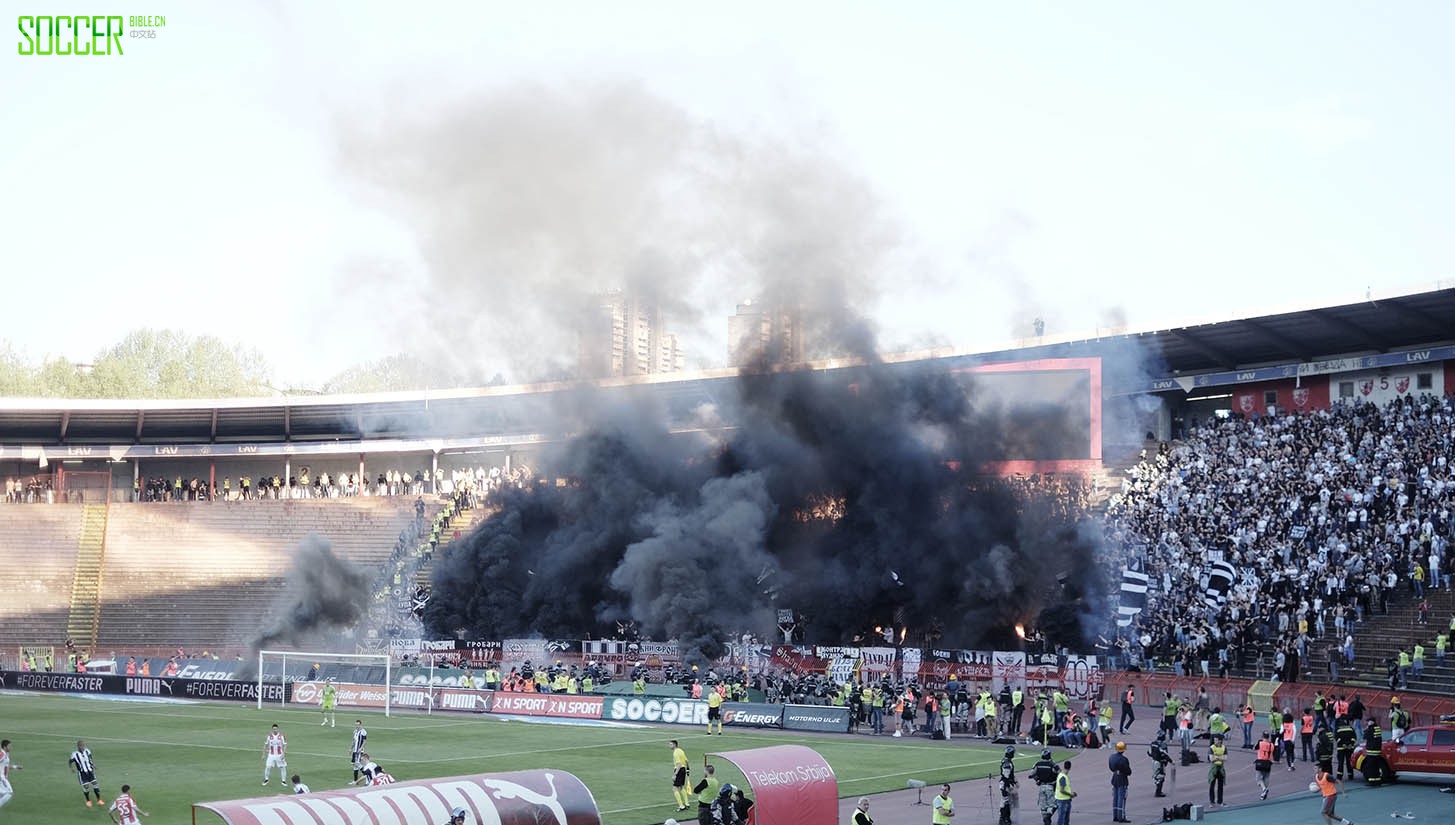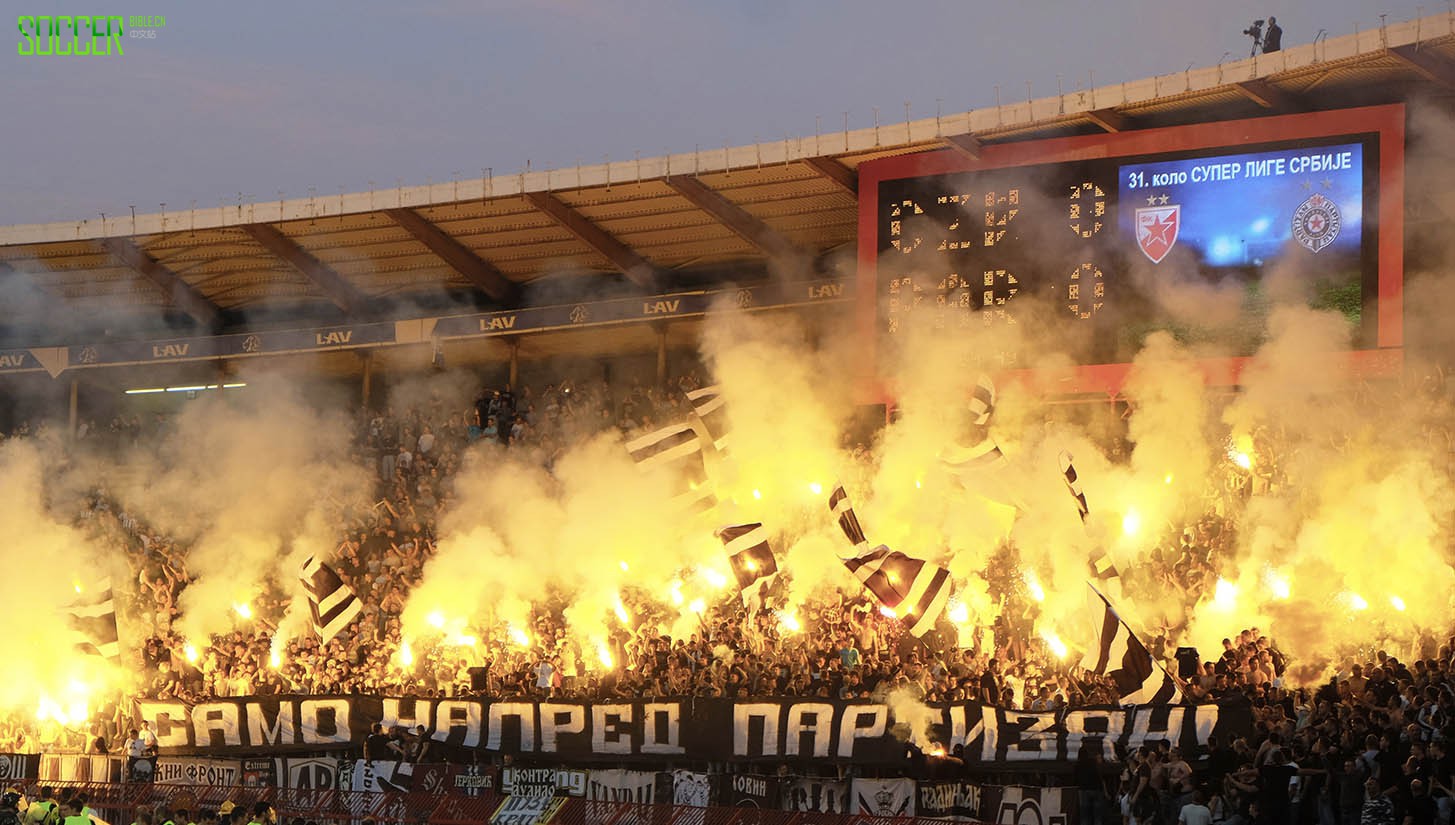An adventure into unchartered waters, french photographers Guillaume Blot and Jérémie Roturier recently travelled to Belgrade to take in the flair fuelled scenes of the Belgrade Derby. A match up between Red Star and Partizan, it's an experience that offers an immersive experience on the scenes. Taking in the sights behind the lens and also recording the sounds, we caught up with Guillaume Blot and Jérémie Roturier to hear about it.
Let's start at the beginning, what inspired the project and took you to the game?
Jérémie: The both of us are massive football fans and sports lovers in general. We’ve previously worked on our own personal projects around sports (joliefoulee.fr and buvettes.com) and we wanted to do something together, exploring new territories and showing the passion for football in Eastern Europe. For the best of it, but also for the worst.
Guillaume: We did our research and found out that one of the most passionate derby on the whole world, between Red Star Belgrade and FK Partizan, was happening the same week-end than Belgrade marathon. The perfect opportunity for us to show the importance of sports in a city that is not necessarily well known in Western Europe. We asked permission to our mums and bought the plane tickets.

As derbies go, how does it compare to ones you may have experienced in the past?
Guillaume: We went to several derbies in France such as PSG-Marseille, Lyon-St Etienne, Nîmes-Montpellier, Bordeaux-Nantes and even Nantes-Rennes with serious fights on the streets, North London derby between Tottenham and Arsenal, Sevilla’s derby, but to be honest you can’t compare any of those with Belgrade’s derby. Except in Bulgaria, other derbies look like Disneyland in comparison.
<iframe allowfullscreen="" frameborder="0" height="293" src="https://www.youtube.com/embed/JSZB91hJZOY?feature=oembed" width="520"></iframe>
Jérémie: There, the show isn’t on the pitch. You can spend the whole game starring at the fury in the stands. You know, historically, Red Star Belgrade was the club of communists, and Partizan the club of the Army. Starting from there you can easily understand the tensions that exist between the Ultras of both sides.
It looks like an incredible outpouring of emotions, can you describe what it was like?
Jérémie: That was incredible! On our way to the stadium, we started seeing rows of anti-riots police. When you cross the path of the first ones you’re like “ok, there must be some tension, let’s just be careful and everything is going to be fine.” So you start taking pictures of them. But then, approaching to the Marakana, you see police everywhere. You’re like starting thinking this must be a serious thing. You look at their faces, and understand you’re in quite a dangerous place.
Guillaume: But then entering in the stadium and walking down the stands it’s a very unique feeling. It takes you straight to the guts. The atmosphere is incredible! We just can’t describe it with words. The thing that stroke us first, is the number of people standing on the main Red Star stand. There are so many of them, they're so packed. This is really impressive. And then you look at the other side, and you see the Partizan fans lighting black flares. So much smoke in the air. You can’t see anything happening on the pitch. At that very moment you think “where the fuck am I?”.
Were there anything that really struck you about the surroundings and the atmosphere?
Guillaume: It’s a war zone! We were experiencing the local food on the surroundings of the stadium, and hearing us talking in English, old men came to us to tell us to get the fuck out of here as we were foreign people.
Jérémie : I can’t imagine if I had kept my Juventus jersey that afternoon - which looks like a lot to the Partizan one - in the Red Star area. Our neighbor beg me to quit it before to hang around in the street before the game. The best advice of our week-end.
Guillaume: You can feel the hatred everywhere. The fans are not there to be joking. It feels like a lot of them come to the game to express some kind of violence they have hidden inside of them. The Ultras enter the stadium as they would enter a battle field. It’s crazy, they started charging the police at half-time for no reason. Pulling out the seats of their own stadium and throwing it away at their faces. Seats were flying like birds in the air! Ultras were running to the policemen shirtless to punch them, bare hands, without any kind of fear or care about the consequences. You could see the damages in the stands, with all the missing seats and the fans laying down to the floor, blood covering their face. This was pure violence.
 It looks beautifully raw, what was it like with camera in hand? Did you come away feeling inspired? Did it go beyond expectations?
It looks beautifully raw, what was it like with camera in hand? Did you come away feeling inspired? Did it go beyond expectations?
Jérémie: To us shooting football is all about showing what’s happening around the pitch. We’re not interested in taking pictures of the game itself, we always try to capture what makes this sport so unique, the fans, the unique atmosphere that you have in a stadium. Our work is about finding the people that will give emotions. There was this guy with his two kids, teaching them how to hold the Red Star scarf. You could really see what football meant for him and that he wanted to convey his love for his club to his boys. This is what we like shooting football games, you always find people that have something special. You just need to be careful sometimes because the fans and especially Ultras don’t really like to be photographed, but talking to them often helps.
Guillaume: We both shoot with a Fujifilm camera and we wanted to keep our photographies as authentic as possible, doing a minimal amount of retouching. For us it’s important to give this feeling that everyone can be part of the action. And with the flags and flares on the stands, the tension with the anti-riot police, we had a lot to capture.
What does football mean to you? Your images show just how much it means to the fans there...
Jérémie: Football is simply life. We grew up with it, playing in clubs since our early days, and still doing a lot of projects around it. My dad brought me to watch my first game in Bordeaux when I was just four years old for the 2nd league finals against Valenciennes. I think I fell in love with football, the Girondins de Bordeaux and Zidane that day.
Guillaume: I think football is a matter of family, that my father also brought me young to La Beaujoire, Nantes’ stadium, at a period when Les Canaris was dominating the championship. And then, when it’s your turn to be on the pitch, you meet new people, who quickly become new brothers and sisters.
Jérémie: Every single time we’re entering in a stadium, we still feel something very special. We feel that nowhere else, still watching it with as we were just kids. Even if we think that because of all the money around the game, it has lost some kind of magic and passion in certain places. But as you can see not in Belgrade. If football is life for us, football is their life.
Where next? Could this become a regular adventure for you guys?
Guillaume: We’re going together to Belgium - Ireland in Bordeaux for the Euro, and other games in Paris. We’ll do something around the fans there, that’s for sure. We’ve also started to think about a project to shoot the atmosphere of the Euro games in pubs to focus on fans emotions.
Jeremie: I went to Budapest a week after Belgrade to shoot the Budapest’s derby between Ferencváros and Újpest, but unfortunately the atmosphere is less impressive now that it was a few years ago because of the move to the new stadium and the government actions to stop hooliganism. Living in London, I am also planning to go to lower Leagues games in the UK to show the passion of the game appart from the Premier League that everyone knows. And on top of that I’m going to Uzbekistan in August to measure the place of football in this country that no one really knows.
Guillaume: I created a project last year about a detail I love around the stadiums : their buvettes (
buvettes.com), which can be translated in English bysnacks, or old-food-trucks-where-you-can-drink-hot-beers. I began in January 2015 a rail-trip in France, to write articles about them, trying to highlight resemblances and differences between each city. Texts are published in So Foot, a french football magazine, and photos belong now to an exhibition, which was shown in Paris in April 2016. I love to shoot those moments when fans all gather before entering in the stadium and have a stop, as a ritual, to their favorite buvette, calling the boss by his name. Like a friend.
 Can we come along for the next ride?
Can we come along for the next ride?
Both: You guys are more than welcome. Always. We’ll keep you posted for our upcoming projects. Get your backpack ready because there’s a lot to come this summer!
You can listen to the atmosphere as recorded by Guillaume, here. Take a look at the work from Jérémie Roturier and Guillaume Blot if you get a chance.


